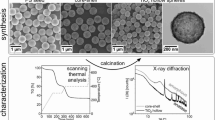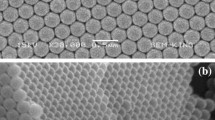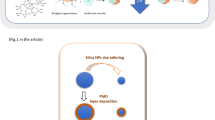Abstract
Hollow spheres made of Bi2Te3 nanoplatelets were successfully synthesized using a low temperature, wet chemical synthesis route. By using a one-pot synthesis, large quantities of microspheres, arranged in a gypsum flower manner, can be obtained in about 1 h. The mechanism leading to such a particular morphology has been deeply studied by both solid and solution characterization techniques (X-ray diffraction, scanning and transmission electron microscopy, X-ray fluorescence, 1H nuclear magnetic resonance spectroscopy) which were carried out at different stages of the synthesis. The key points are the generation of alcanethiol-in-polyol droplets and the subsequent in situ controlled interfacial reaction between Te and Bi precursors. The Te(IV) ions present in the alcanethiol phase are initially reduced into Te(0) by decanethiol. The Bi(III) ions initially dissolved in the polyol phase are then reduced at the decanethiol/polyol interface, resulting in the progressive growth of Bi2Te3 hexagonal nanoplatelets at the outer surface of the pristine Te(0) sphere.











Similar content being viewed by others
References
Brayner R, Fievet F, Coradin T (2013) Chapter 1: the polyol process. Nanomaterials: a danger or a promise. Springer, New York, pp 1–25
Fievet F (2000) Metals. Polyol Process Surfactant Sci Ser 92:460–496
Fievet F, Lagier JP, Blin B, Beaudoin B, Figlarz M (1989) Homogeneous and heterogeneous nucleations in the polyol process for the preparation of micron and submicron size metal particles. Solid State Ionics 32–33:198–205. doi:10.1016/0167-2738(89)90222-1
Fleischer H, Mitzel NW, Schollmeyer D (2003) Tellurium(II) dialkanethiolates: np(S)-σ*(Te-S’) orbital interactions determine the 125Te NMR chemical shift, and the molecular and crystal structure. Eur J Inorg Chem 2003:815–821. doi:10.1002/ejic.200390111
Fu J, Song S, Zhang X, Cao F, Zhou L, Li X, Zhang H (2012) Bi2Te3 nanoplates and nanoflowers: synthesized by hydrothermal process and their enhanced thermoelectric properties. CrystEngComm 14:2159–2165. doi:10.1039/c2ce06348d
Gao J, Zhang B, Zhang X, Xu B (2006) Magnetic-dipolar-interaction-induced self-assembly affords wires of hollow nanocrystals of cobalt selenide. Angew Chem Int Ed 45:1220–1223. doi:10.1002/anie.200503486
Guo L et al (2007) Uniform magnetic chains of hollow cobalt mesospheres from one-pot synthesis and their assembly in solution. Adv Funct Mater 17:425–430. doi:10.1002/adfm.200600415
Hu J, Chen M, Fang X, Wu L (2011) Fabrication and application of inorganic hollow spheres. Chem Soc Rev 40:5472–5491. doi:10.1039/c1cs15103g
Jiang Y, Zhu Y-J, Chen L-D (2007) Microwave-assisted preparation of Bi2Te3 hollow nanospheres. Chem Lett 36:382–383. doi:10.1246/cl.2007.382
Kanatzidis MG (2010) Nanostructured thermoelectrics. The new paradigm? Chem Mater 22:648–659. doi:10.1021/cm902195j
Kim KT, Kim D-W, Ha GH (2010a) Direct synthesis of Te/Bi2Te3 nanocomposite powders by a polyol process. Res Chem Intermed 36:835–841. doi:10.1007/s11164-010-0188-4
Kim KT, Lee HM, Kim DW, Kim KJ, Ha GH, Lee G-G (2010b) Bismuth-telluride thermoelectric nanoparticles synthesized by using a polyol process. J Korean Phys Soc 57:1037–1040. doi:10.3938/jkps.57.1037
Kim C, Kim DH, Han YS, Chung JS, Park S, Kim H (2011) Fabrication of bismuth telluride nanoparticles using a chemical synthetic process and their thermoelectric evaluations. Powder Technol 214:463–468. doi:10.1016/j.powtec.2011.08.049
Lai X, Halpert JE, Wang D (2012) Recent advances in micro-/nano-structured hollow spheres for energy applications: from simple to complex systems energy. Environ Sci 5:5604–5618. doi:10.1039/c1ee02426d
Li Y, Shi J, Hua Z, Chen H, Ruan M, Yan D (2003) Hollow spheres of mesoporous aluminosilicate with a three-dimensional pore network and extraordinarily high hydrothermal stability. Nano Lett 3:609–612. doi:10.1021/nl034134x
Li L, Cao R, Wang Z, Li J, Qi L (2009) Template synthesis of hierarchical Bi2E3 (E = S, Se, Te) core-shell microspheres and their electrochemical and photoresponsive properties. J Phys Chem C 113:18075–18081. doi:10.1021/jp906407n
Liu H, Qu J, Chen Y, Li J, Ye F, Lee JY, Yang J (2012) Hollow and cage-bell structured nanomaterials of noble metals. J Am Chem Soc 134:11602–11610. doi:10.1021/ja302518n
Lu Y, McLellan J, Xia Y (2004) Synthesis and crystallization of hybrid spherical colloids composed of polystyrene cores and silica shells. Langmuir 20:3464–3470. doi:10.1021/la036245h
Mai NT, Mott D, Nguyen TBT, Osaka I, Maenosono S (2011) Study on formation mechanism and ligand-directed architectural control of nanoparticles composed of Bi, Sb and Te: towards one-pot synthesis of ternary (Bi,Sb)2Te3 nanobuilding blocks. RSC Adv 1:1089–1098. doi:10.1039/c1ra00069a
Mehta RJ, Karthik C, Singh B, Teki R, Borca-Tasciuc T, Ramanath G (2010) Seebeck tuning in chalcogenide nanoplate assemblies by nanoscale heterostructuring. ACS Nano 4:5055–5060. doi:10.1021/nn101322p
Mott D, Mai NT, Thuy NTB, Maeda Y, Linh TPT, Koyano M, Maenosono S (2011) Bismuth, antimony and tellurium alloy nanoparticles with controllable shape and composition for efficient thermoelectric devices. Phys Status Solidi A 208:52–58. doi:10.1002/pssa.201026485
Nakashima T, Kimizuka N (2003) Interfacial synthesis of hollow TiO2 microspheres in ionic liquids. J Am Chem Soc 125:6386–6387. doi:10.1021/ja034954b
Pearson RG (1968) Hard and soft acids and bases (HSAB), part I: fundamental principles. J Chem Educ 45:581–587. doi:10.1021/ed045p581
Purkayastha A, Lupo F, Kim S, Borca-Tasciuc T, Ramanath G (2006) Low-temperature, template-free synthesis of single-crystal bismuth telluride nanorods. Adv Mater 18:496–500. doi:10.1002/adma.200501339
Son JS et al (2012) n-Type nanostructured thermoelectric materials prepared from chemically synthesized ultrathin Bi2Te3 nanoplates. Nano Lett 12:640–647. doi:10.1021/nl203389x
Soni A, Yanyuan Z, Ligen Y, Aik MKK, Dresselhaus MS, Xiong Q (2012) Enhanced thermoelectric properties of solution grown Bi2Te3-xSex nanoplatelet composites. Nano Lett 12:1203–1209. doi:10.1021/nl2034859
Sun Y, Mayers B, Xia Y (2003) Metal nanostructures with hollow interiors. Adv Mater 15:641–646. doi:10.1002/adma.200301639
Wang Y, Su F, Lee JY, Zhao XS (2006) Crystalline carbon hollow spheres, crystalline carbon-SnO2 hollow spheres, and crystalline SnO2 hollow spheres: synthesis and performance in reversible Li-ion storage. Chem Mater 18:1347–1353. doi:10.1021/cm052219o
Wang T et al (2010) Microsphere bouquets of bismuth telluride nanoplates: room-temperature synthesis and thermoelectric properties. J Phys Chem C 114:1796–1799. doi:10.1021/jp908727b
Witt D, Klajn R, Barski P, Grzybowski BA (2004) Applications, properties and synthesis of ω-functionalized n-alkanethiols and disulfides—the building blocks of self-assembled monolayers. Curr Org Chem 8:1763–1797. doi:10.2174/1385272043369421
Yang HG, Zeng HC (2004) Self-construction of hollow SnO2 octahedra based on two-dimensional aggregation of nanocrystallites. Angew Chem Int Ed 43:5930–5933. doi:10.1002/anie.200461129
Zhang G, Fang H, Yang H, Jauregui LA, Chen YP, Wu Y (2012a) Design principle of telluride-based nanowire heterostructures for potential thermoelectric applications. Nano Lett 12:3627–3633. doi:10.1021/nl301327d
Zhang G, Kirk B, Jauregui LA, Yang H, Xu X, Chen YP, Wu Y (2012b) Rational synthesis of ultrathin n-type Bi2Te3 nanowires with enhanced thermoelectric properties. Nano Lett 12:56–60. doi:10.1021/nl202935k
Zhao C-X, Middelberg APJ (2013) One-step fabrication of titania hollow spheres by controlled interfacial reaction in a droplet-based microfluidic system. Microfluid Nanofluid 14:703–709. doi:10.1007/s10404-012-1088-2
Zhou B, Zhao Y, Pu L, Zhu J-J (2006) Microwave-assisted synthesis of nanocrystalline Bi2Te3. Mater Chem Phys 96:192–196. doi:10.1016/j.matchemphys.2005.07.010
Zhu H, Wang J, Xu G (2009) Fast synthesis of Cu2O hollow microspheres and their application in DNA biosensor of hepatitis B virus. Cryst Growth Des 9:633–638. doi:10.1021/cg801006g
Acknowledgments
We would like to thank the following persons for their help in materials characterization: Patricia Beaunier for TEM, Hélène Lecoq for SEM, Philippe Decorse for XPS, and Marco Faustini and Jean-Yves Piquemal for fruitful discussions.
Author information
Authors and Affiliations
Corresponding authors
Electronic supplementary material
Below is the link to the electronic supplementary material.
Rights and permissions
About this article
Cite this article
Fouineau, J., Peron, J., Nowak, S. et al. Soft chemistry synthesis route toward Bi2Te3 hierarchical hollow spheres. J Nanopart Res 17, 166 (2015). https://doi.org/10.1007/s11051-015-2968-7
Received:
Accepted:
Published:
DOI: https://doi.org/10.1007/s11051-015-2968-7




